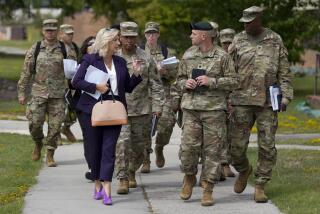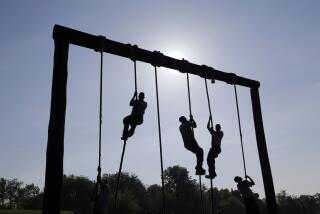National Guard Falls Short in Hitting Troop Level Goals
- Share via
WASHINGTON — Strained by ongoing military action in Iraq and Afghanistan, the National Guard has fallen nearly 15,000 troops short of its authorized level of 350,000, Lt. Gen. H. Steven Blum, chief of the guard, said Tuesday.
The guard, which had met its authorized numbers annually since 1989, has suffered shortfalls in recruitment since last fall; last month officials unveiled changes to keep the force stable. Blum said that with additional recruiting improvements and other steps, the personnel shortage could be corrected by September.
“It’s not a train wreck. It’s not a crisis. But it bears watching,” Blum said, noting there were 335,490 guard troops. “I’d like to have 350,000.”
The National Guard, like the smaller Army Reserve, has faced difficulty filling its slots because of the extended and sometimes unpredictable deployments that have been required by the Iraq war, a conflict that has forced the guard to play a major role.
Most acutely, the National Guard has suffered from a drop in the number of full-time soldiers who join after they are discharged from other branches of the military, Blum said. Before the Iraq and Afghanistan wars, about 50% of troops joined the guard upon leaving the active-duty services. That number has dropped to about 35% today, Blum said. Former soldiers have said discharged troops are reluctant to join the guard, fearing doing so could land them back in Iraq.
Blum said he expected the Pentagon to seek congressional approval to give $15,000 bonuses to active-duty soldiers who joined the guard, and matching bonuses for guard troops in key units who signed up for another six-year stint. They now get a token $50, he said. Blum told reporters at the Pentagon that he expected to meet the goal of 350,000 troops by the time the official annual figure was registered at the end of the fiscal year in September.
The new incentives, along with others being offered, could solve the problems of troop levels and the unpopular requirement that guard troops serve more than 24 months in war zones.
One new program, announced in November, tripled retention bonuses to $15,000 for guard troops who signed up for another six-year stint -- an amount that was tax free to soldiers in the war zones. The guard also boosted the number of recruiters from 2,700 to 4,100 and adjusted its advertising campaigns and slogans, shifting away from appeals to so-called weekend warriors and more toward potential recruits who would more readily accept deployment abroad.
The wars in Iraq and Afghanistan have underscored recruiting and retention problems that have worsened since the National Guard first fell 7,000 recruits short of its targets in September.
The National Guard and Army Reserve make up about 40% of the nearly 150,000 troops serving in Iraq.
The Army Reserve’s top commander told Pentagon officials in a blunt memo earlier this month that the Reserve would become a “broken force” without changes in overall military policy. For example, reserve commanders have complained of requirements that discourage potential recruits.
In Iraq, guard members alone make up 32% of the 108,916 Army troops, and 44% of the combat force in infantry and armored units -- an all-time high. The number of guard members serving in combat roles would be reduced by about half during the next rotation of troops in Iraq in 2006, Blum said.
Although governors have expressed concern that so many of their states’ guard troops are unavailable because of deployments to Iraq, Blum said that no state had less than half its guard force available at home, and only two states -- Hawaii and Washington -- had reached as low as 50%.
More to Read
Sign up for Essential California
The most important California stories and recommendations in your inbox every morning.
You may occasionally receive promotional content from the Los Angeles Times.










